Automotive Memory Chip Research: Localization is imperative amid intense competition
The global smart phone storage market size hit US$46 billion in 2021 when the global automotive storage market size reached about US$4.5 billion, which is only equivalent to 1/10 of the former. Under development trend of intelligent connected vehicles, automobiles will become one of main growth engines of memory IC industry. By 2027, global automotive storage market size will exceed US$12.5 billion, with a CAGR of 18.6% from 2021 to 2027.
According to Micron Technology, the automotive storage market in China amounted to about US$700 million in 2021, and it will jump to US$1.5 billion by 2023. On the one hand, the growth momentum comes from growth of automobile shipments in China; on the other hand, it also benefits from continuous expansion of automotive memory and memory capacity.
High-level autonomous vehicles have posed enormous demand for automotive memory capacity, density and bandwidth
At present, main storage applications in automotive market include DRAM(DDR, LPDDR) and NAND (e.MMC and UFS, etc.). Low-power LPDDR and NAND will be main growth engines, and the demand for NOR Flash, used for chip startup, will continue to increase. In addition, higher intelligent driving levels will have a direct impact on the demand for GDDR, which is RAM specially used for ADAS floating-point computing chips in vehicles.
More powerful sensors, ADAS/AD integrated systems, central computers, digital cockpits, event recording systems,terminal-cloud computing, vehicle FOTA, etc. all put forward higher requirements for automotive memory. On the one hand, the memory capacity will go up from gigabytes (GB) to terabytes (TB); on the other hand, the memory density and bandwidth will be greatly improved.
For example, NAND Flash mainly store continuous data in ADAS, IVI systems, automotive center console systems, etc. As autonomous driving levels up, the demand for NAND capacity in ADAS has swelled. Generally, L1/L2 ADAS only requires the mainstream 8GB e-MMC, L3 needs 128/256GB, and L5 may involve over 2TBt. In the future, the data production, transmission and recording of advanced autonomous vehicles will require higher density and speed, so that PCIe SSD may be adopted.
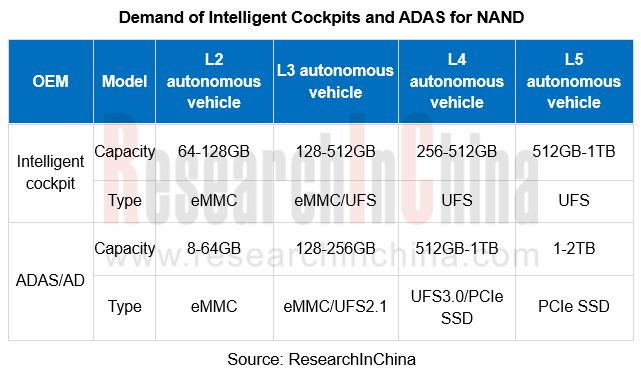
Autonomous vehicles boast more and more internal and external perception devices, including front cameras, internal cameras, high-resolution imaging radar, LiDAR, etc., and they will exploit high-density NOR Flash(QSPI, xSPI, etc., for chip startup) and DRAM(LPDDR3/4, LPDDR5, GDDR, etc.) widely.
At present, L1-L2 autonomous vehicles largely use LPDDR3 or LPDDR4, with the bandwidth of 25-50 GB/s. The bandwidth requirement is raised to 200GB/s for L3 autonomous driving, 300GB/s for L4 and 500GB/s for L5. Therefore, LPDDR5 and GDDR6 with higher bandwidth can simplify the system design of high-level autonomous vehicles.
Counterpoint’s data shows that in the next decade, the memory capacity of a single vehicle will reach 2TB~11TB, catering to the requirements of different autonomous driving levels.
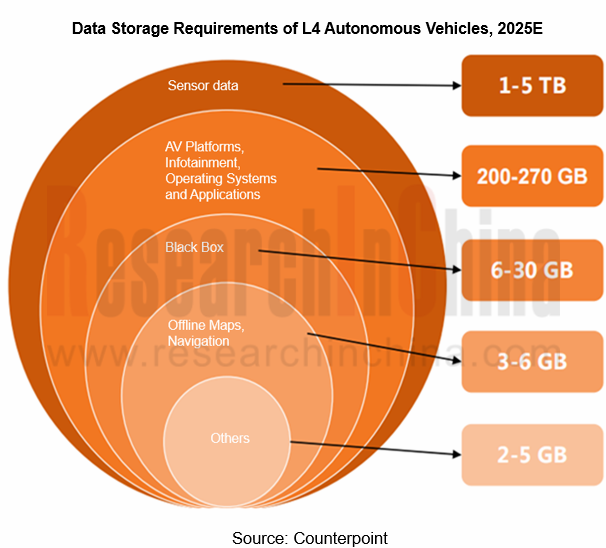
At the same time, autonomous driving is driven by data. The development of ADAS platforms needs massive road test data from cameras, radar, LiDAR, GPS and the like. These data are uploaded to the cloud for storage, AI training, simulation testing and verification. A one-hour L2 or L4-L5 road test probably generates 2TB or 16-20TB of data correspondingly, so that a single road test will produce 8-60TB of data, and the entire development cycle will churn out exabytes (EB) of data.
This has triggered huge market demand for autonomous driving cloud storage. In China, there are many cloud service providers that offer product solutions for autonomous driving data cloud storage, including Tencent Cloud, Alibaba Cloud, WD My Cloud, Sugon ParaStor, YRCloudFile, XSKY and so on.
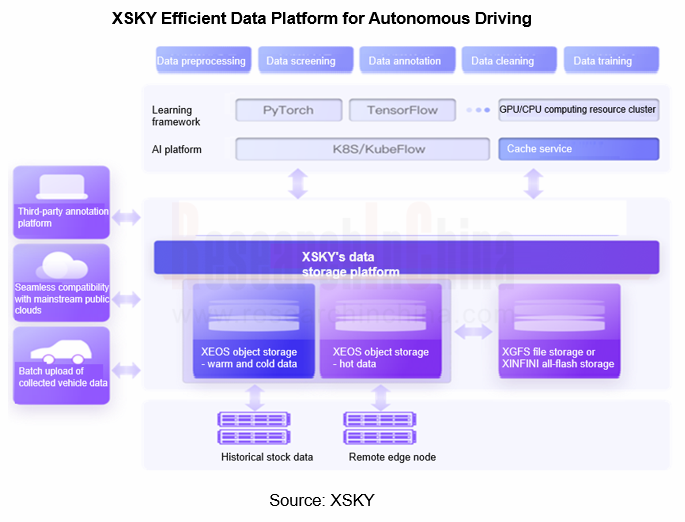
As the functions of intelligent cockpits become more and more diversified, larger storage capacity is constantly in demand, and storage technology is constantly innovating
With the wide application of central integrated digital cockpits, DRAM has evolved from DDR2 and DDR3 to LPDDR4, LPDDR5 or GDDR. In addition, the interface of mobile phones has transferred from eMMC to UFS, so will smart cockpit memory chips. It is also possible for high-end models to adopt PCIe SSD.
The cores of both UFS and eMMC interfaces involve NAND flash, but their control interfaces follow different protocols. The maximum communication rate of eMMC is 400MB/s, relative to 1,160 MB/s of UFS. The communication speed directly affects the startup time and software loading time of vehicles, which offer varying experience. In response to the demand for faster startup, reading and writing, the storage in the cockpit field must support UFS2.1 at least. Qualcomm's third-generation 8155 cockpit SoC has already endorsed UFS interfaces.
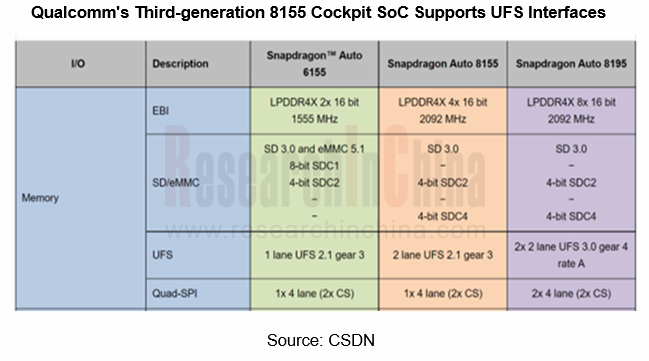
The intelligent cockpits of newly launched models demonstrate the increasingly powerful storage capacity:
?Xpeng P7 launched in 2020 is equipped with Qualcomm Snapdragon 820A with 8G memory + 128GB storage, enabling users to download more automotive Apps, supporting applet expansion, and featuring both practicality and fun;
?The next-generation SA8155P-based ZEEKR intelligent cockpit, available in ZEEKR 001 unveiled in 2021, has an 8-core CPU of the 7 nm process, with 16G memory and 128GB storage.
?Li L9 which debuted in 2022 comes standard with two Qualcomm Snapdragon 8155 chips with 24G memory and 256GB high-speed storage, which together form a powerful computing platform.
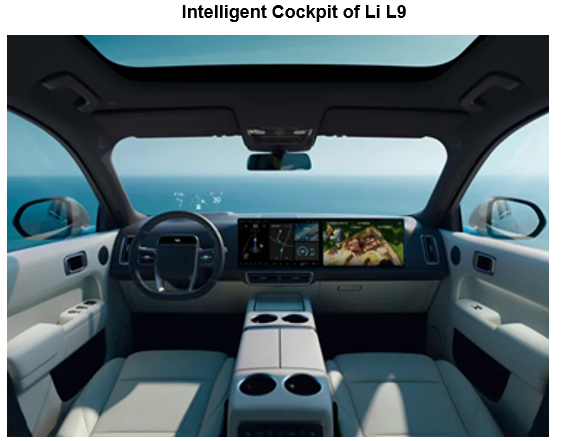
Chinese storage suppliers accelerate deployment in the promising automotive storage market
The requirements for automotive storage products are much higher than those for consumer electronics. Automotive-grade storage products have to take a long R&D and verification cycle, undergo a complicated certification process, comply with IATF16949, ASPCIE and ISO 26262, and satisfy the standards of some automakers, such as GMW3172 and VW80000. As a result, this market poses high barriers to entry and embodies obvious oligopoly.
Overseas storage vendors such as Micron, Samsung, SK Hynix and Microchip still dominate the development of the automotive storage industry as monopolists. Among them, Micron enjoys the global market share of over 45%. In 2021, Micron launched its industry-leading automotive LPDDR5 certified by ISO 26262 ASIL-D, with the maximum capacity of 128GB.
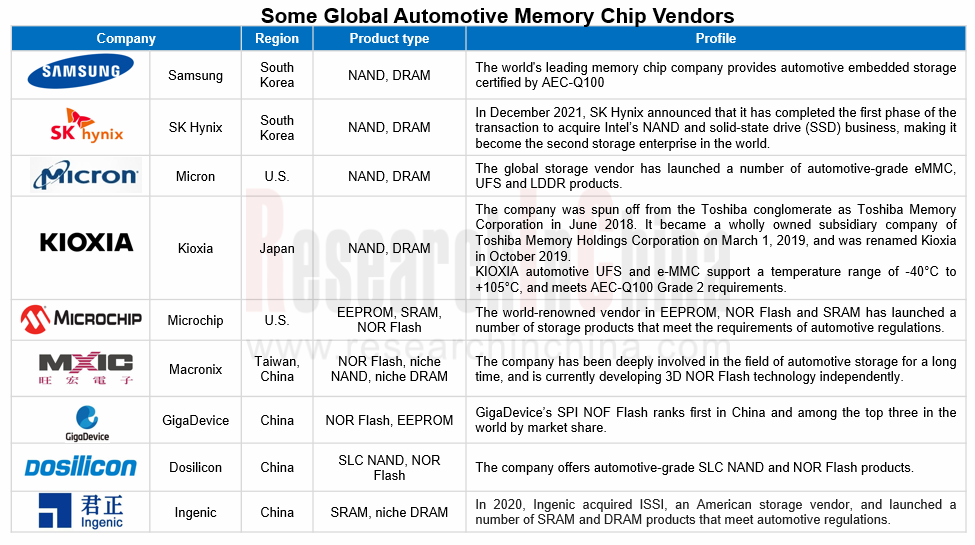
In recent years, Chinese memory chip vendors have made great efforts in automotive storage products:
SRAM: Ingenic has been focusing on independent CPU, SoC and AI engines for many years. In 2020, it acquired 100% stake in Beijing ISSI. By virtue of intellectual property rights, it can completely avoid the impact of the sanctions imposed by the United States government, independently develop and produce SRAM in line with automotive regulations, and produce niche DRAM. Ingenic has reached close cooperation with auto parts vendors such as Bosch and Continental.
EEPROM: Giantec Semiconductor, a leading EEPROM enterprise in China, launched GT24C512B, a high-reliability automotive A1-grade memory chip, in August 2022, which can withstand erasing and writing for up to 4 million times at room temperature, and has been applied to OBC, VCU and other related fields.
NOR Flash: GigaDevice has delved in the field of NOR Flash for many years. By market share, it ranks first in China and third in the world. The GD25 series launched by GigaDevice is the only mass-produced NOR Flash in China that meets AEC-Q100, with the storage capacity of 2Mb~2Gb.
In addition to OEMs, there is another type of storage players in China, like Longsys, BIWIN Storage Technology and Powe, who buy wafers and particles from IDMs and purchase master chips from third-party master chip vendors, then conduct packaging tests through their own or third-party packaging and testing factories, and produce storage products of different storage types, interfaces and standards.
Automotive 4D Radar Industry Research Report 2025
4D radar research: From "optional" to "essential," 4D radar's share will exceed 50% by 2030.
1. 4D imaging radar has transformed from an "optional" to a "must-have" sensor.
4D radar adds the detecti...
China Automotive Multimodal Interaction Development Research Report, 2025
Research on Automotive Multimodal Interaction: The Interaction Evolution of L1~L4 Cockpits
ResearchInChina has released the "China Automotive Multimodal Interaction Development Research Report, 2025"...
Automotive Vision Industry Report, 2025
Automotive Vision Research: Average Camera Installation per Vehicle Reaches 5.2 Units, and Front-View Tricam Installation Exceeds 1.2 Million Sets.
From January to September 2025, the total installa...
Automotive Infrared Night Vision System Research Report, 2025
Automotive night vision research: The rise of infrared AEB, with automotive infrared night vision experiencing a 384.7% year-on-year increase from January to September.
From January to September 2025...
New Energy Vehicle Cross-Domain (Electric Drive System and Powertrain Domain) Integration Trend Report 2025-2026
Electric Drive and Powertrain Domain Research: New technologies such as three-motor four-wheel drive, drive-brake integration, and corner modules are being rapidly installed in vehicles.
Electric dri...
Analysis on Desay SV and Joyson Electronic's Electrification, Connectivity, Intelligence and Sharing, 2025
Research on Desay SV and Joyson Electronic: Who is the No.1 Intelligent Supplier?
Both Desay SV and Joyson Electronic are leading domestic suppliers in automotive intelligence. "Analysis on Desay SV ...
OEMs and Tier 1 Suppliers' Cost Reduction and Efficiency Enhancement Strategy Analysis Report, 2025
ResearchInChina released the "OEMs and Tier 1 Suppliers' Cost Reduction and Efficiency Enhancement Strategy Analysis Report, 2025", summarizing hundreds of cost reduction strategies to provide referen...
Automotive Fixed Panoramic Sunroof and Smart Roof Research Report, 2025
With the intelligent application of car roofs as the core, this report systematically sorts out a series of new products such as fixed panoramic sunroof/openable sunroof, ceiling screen, roof ambient ...
Automotive-Grade Power Semiconductor and Module (SiC, GaN) Industry Research Report, 2025
SiC/GaN Research: Sales volume of 800V+ architecture-based vehicles will increase more than 10 times, and hybrid carbon (SiC+IGBT) power modules are rapidly being deployed in vehicles.
Sales volume o...
Cockpit Agent Engineering Research Report, 2025
Cockpit Agent Engineering Research: Breakthrough from Digital AI to Physical AI
Cockpit Agent Engineering Research Report, 2025 starts with the status quo of cockpit agents, summarizes the technical ...
Prospective Study on L3 Intelligent Driving Technology of OEMs and Tier 1 Suppliers, 2025
L3 Research: The Window of Opportunity Has Arrived - Eight Trends in L3 Layout of OEMs and Tier 1 Suppliers
Through in-depth research on 15 OEMs (including 8 Chinese and 7 foreign OEMs) and 9 Tier 1 ...
China Commercial Vehicle IoV and Intelligent Cockpit Industry Research Report 2025
Commercial Vehicle IoV and Cockpit Research: The Third Wave of Passenger Car/Commercial Vehicle Technology Integration Arrives, and T-Box Integrates e-Call and 15.6-inch for Vehicles
I. The third wav...
Intelligent Vehicle Electronic and Electrical Architecture (EEA) and Technology Supply Chain Construction Strategy Research Report, 2025
E/E Architecture Research: 24 OEMs Deploy Innovative Products from Platform Architectures to Technical Selling Points
According to statistics from ResearchInChina, 802,000 passenger cars with domain...
Research Report on Intelligent Vehicle Cross-Domain Integration Strategies and Innovative Function Scenarios, 2025
Cross-Domain Integration Strategy Research: Automakers' Competition Extends to Cross-Domain Innovative Function Scenarios such as Cockpit-Driving, Powertrain, and Chassis
Cross-domain integration of ...
China Autonomous Driving Data Closed Loop Research Report, 2025
Data Closed-Loop Research: Synthetic Data Accounts for Over 50%, Full-process Automated Toolchain Gradually Implemented
Key Points:From 2023 to 2025, the proportion of synthetic data increased from 2...
Automotive Glass and Smart Glass Research Report, 2025
Automotive Glass Report: Dimmable Glass Offers Active Mode, Penetration Rate Expected to Reach 10% by 2030
ResearchInChina releases the Automotive Glass and Smart Glass Research Report, 2025. This r...
Passenger Car Brake-by-Wire (BBW) Research Report, 2025
Brake-by-Wire: EHB to Be Installed in 12 Million Vehicles in 2025
1. EHB Have Been Installed in over 10 Million Vehicles, A Figure to Hit 12 Million in 2025.
In 2024, the brake-by-wire, Electro-Hydr...
Autonomous Driving Domain Controller and Central Computing Unit (CCU) Industry Report, 2025
Research on Autonomous Driving Domain Controllers: Monthly Penetration Rate Exceeded 30% for the First Time, and 700T+ Ultrahigh-compute Domain Controller Products Are Rapidly Installed in Vehicles
L...